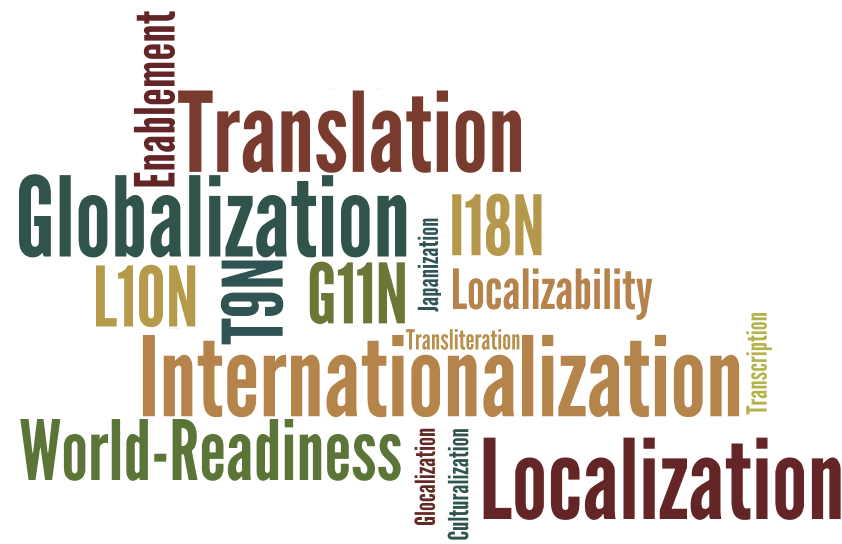In Today’s competitive world many of the clients are targeting the global audience, which means going beyond borders and working with clients to make sure application has proper global sets in terms of functional, readable, and viewable in multiple platforms and cross-browsers. Along with that there are many languages in the world, so in this situation do we need to create a separate application or website for each languages & countries? The answer is NO. This can be accomplish by simply doing the code in such a way that changing the text in the file they can localize the product in any language & this type of testing is called as Globalization (Internationalization) and Localization Testing.
Overall summary of what is mean by Globalization, Internationalization and Localization Testing?
- Translation is one part of Localization
- Internationalization is a pre-requisite of Localization
- Internationalization and Localization are parts of Globalization
- Globalization includes many business-related activities outside of the product itself.
In this article I am focusing on what all best practices to be followed for Globalization and Localization Testing. Also we are discussing all common bugs found from this type of testing. Prior to start, many testers are thinking about what is use of Localization Testing and Globalization Testing and Is it really needed to execute such type of testing for all projects? I would say, it is totally based on the requirements & how & where the product going to be used.

Aim of Internationalization and Localization testing is to make sure usability, acceptability, reliability to audience and users worldwide & check whether the application under test is ready for world-readiness. First application under test needs to be localized & then tested for many other counts like locale, copy text, language, compatibility, reliable functionality and interoperability.
What is Globalization (Internationalization) Testing?
Globalization definition: Globalization Testing is testing process to check whether software can perform properly in any locale or culture & functioning properly with all types of international inputs and steps to effectively make your product truly global. This type of testing validates whether the application is capable for using all over the world and to check whether the input accepts all the language texts.
It is also called as “G11N“, because there as 11 characters in between G & N. It ensures that the product will handle international support without breaking functionality. Globalization testing mainly focuses on the functionality of the product with any culture/locale settings and every type of possible international input. It also helps uncover issues that may increase the costs of localization and future product support later on.
What is Localization Testing?
Localization definition: Localization testing is testing process to validate whether application is capable enough for using in a particular location or country. In this testing localization, testing is to carried out to check the quality of the product for particular locale/culture. To check the quality of translation in localization testing, we should request local staff as well. It is to be carried out to check the localized version of the product, For example: French product for French users. It is also called as “L10N“, because there as 10 characters in between L & N.
Let’s see another example of a Zip code field in Sign up form:
1) For globalized, it should allow to enter alphanumeric inputs
2) For localized (country like INDIA), it should allow only numbers in input field.
One more nice example of Localization:

What we need to test in Internationalization or Globalization?
- Check for the functionality with different language setting. It might possible that functionality may not work other than English setting. Here is one example of API which cause problem in the communication between Consumer and Owner. In the API, they forgot to make agreement for data format, one is using English language & one is using local format.
- Check if no any hard-coded string use in the code. You can test with the different language by changing the language setting from Computer.
- Check the Numbers, Currencies, Character sets for different countries.
Benefits of for Localization and Globalization Testing
- It reduces overall testing costs
- It reduces the support costs
- It help to reduce time for testing which result faster time-to-market
- It has more flexibility and scalability.
Conclusion: The Localization Testing and Globalization testing is done for adapting a product to a local or regional market & it’s goal is to make appropriate linguistic and cultural aspects of product. These testing performed with the help of by translators, language engineers & localizers. Now we understand the importance of Localization Testing and Globalization Testing and the risk if we don’t have this type of software testing. It is very much important to execute the Globalization Testing and Localization Testing in international product.
I think I have addressed all major points in Globalization (Internationalization) Testing and Localization Testing. If you LIKE this article, you would also Like to Subscribe to our software testing email newsletter for software testing latest updates. I will keep on updating the article for latest testing information.
Happy Testing!!
- Smoke Testing
- What is Installation Testing?
- Gray Box Testing
- What is Exploratory Testing?
- Security Testing approach for Web Application Testing
- Positive and Negative Testing In Software Testing
- Detailed Understand of Usability Testing: What? Why? & How?
- Tutorial 2: Introduction to Mobile Testing Application
- What is a Crowdsourced Testing?
- The Best Usability Testing Methods to Use on A Regular Basis

5 thoughts on “What is Globalization and Localization in Software Testing?”
Excellent :)
Great explanations:-)Thanks
Is Globalization testing comes under white box testing or Black box testing? plz clarify.
Black box testing..
Hello,
Can you please inform any sites to learn advanced sql and pl/sql to write nested queries and queries at developer level.
thanks
sujatha